Monday, 19 April 2010
One of the product companies we included in our film was ‘Paramount Pictures’. This was due to the genre and style of our film. The film is a violent gangster/mafia type of movie and therefore we compared it to movies such as The Godfather whose product company was Paramount Pictures. We also made up the name of a production company and named it ‘One Shot Pictures’. This is because we thought our film would be able to get new companies to invest in us and promote us and a company like one shot pictures would therefore be promoting violent gangster type movies. The film may not be totally British so we could be open to a wider audience such as America and Europe. This is because the genre chosen is a popular genre and therefore should be open to the wider market.
If I had the chance I would first like to show my film at a film festival. This is because I am not experienced and would therefore want to learn from other film makers and see how I large diverse audience would react to my film. I could therefore see what I need to improve when starting off at small conventions like these and possibly build up a filming career when bigger events and chances come up.
The film may be released on DVD very soon after being bought out due to the fact that we would have companies such as Paramount Pictures involved. The DVD distribution would make the film more assessable and possibly boost ratings.
We filmed within Lauren’s house and the area outside where we filmed was very close to her house, therefore we met up at her house each time we filmed and kept all the filming equipment at her house during the periods of not filming. Due to the fact that we thought we were going to film at night we had some lighting equipment to use when filming, however it was a lot more effective and easier to use natural lighting during the day. It took us two days to film the two different sections; the first part was within the house until the ‘Leading to Bell View’ sign. The second day we filmed the rest of the outside shots and used our second actor played by Daniel Wolff.
I filmed some low angle shots and some close ups within the first scene in the house where the detective is gathering some evidence. I wanted to get many angles of our character to show the different aspects of what was happening within the scene and so that in editing we could easily piece our shots together so that our film could flow thoroughly and easily. The close-ups meant the audience could see the detectives facial expressions and hopefully read off his face that he was nervous, however determined. It is important the audience can read these facial expressions so they can relate to what the character is thinking and understand the situation, therefore the camera shots I incorporated are very important. There were some other shots that I filmed that when it came to editing we realised we did not need and therefore are not shown in our finalised film. I shot the over-the-shoulder shots when the detective and Letch are having a conversation. This was partly due to the fact that I am tall and can therefore easily capture the shots, also I was good at holding the camera steady and capturing the characters from the correct angles. When editing we each put our views forward towards each part and pieced the film together in parts, all taking it in turns. I first started to edit the basic outline of what we had which made it easier to pick out the correct shots which we all later edited together and finalised. I chose where we should place the titles within the opening scene and I became good at finalising the music and placing it in the correct spots so that it corresponded with the film.
The digital technology was very helpful as it enabled us to capture the different shots in high quality and in the way we pictured and wanted it. For instance the zooming in and out feature was very useful and we used this quite a lot such as in our first establishing shot when we zoomed into the house. We also used this feature for close ups so that we could capture the perfect shot on the characters face. However some problems with the technology that we encountered was the focus. At some points in our film such as the first scene in the house the camera goes slightly out of focus whilst filming and this was hard to control. The sound was also hard to monitor whilst filming as we could not quite tell what sound we had captured and at one point the sound recorder on the camera broke and did not capture any background sounds.
The internet was a very useful technology when researching ideas and clips for our film. Websites such as ‘YouTube’ were very helpful as we could pick out specific points in a film or a sequence and try and compare it to our ideas and our film. I watched DVD’s as well to gain ideas when researching what different types of characters and genres we could use in our film.
The fiction film was designed to create a sense of disorientation with what was happening within the storyline. When the character is walking towards his destination to make the deal the music we chose proved to be very important in creating the correct mood and tone. The killing at the end of our extract was meant to provide a sense of shock and anxiety. It would prepare our audience for a violent and action-packed movie. At the end of our extract the audience wanted to know what was to happen next, the start of our film certainly proved sufficient enough to prepare our audience to carry on watching our fiction film.
Our first establishing shot was so that our audience could picture where the film was taking place. The zoom towards the window was so that it suggested to our audience that the next scene with our character within a room was taking place in that house. Within the next scene our character spoke on the phone to someone else, he mentioned, “Be at Bell View in ten minutes”. Therefore when we filmed him walking towards his destination we paused the camera on a sign which stated ‘Leading to Bell View’. This therefore reminded the audience of where his destination was and kept them guessing at the reasons why he may be going there. The meaning of this film is to create suspense and to show that things are not quite right in what is being shown. We therefore portrayed this in our filming by always getting our character to look around and to show nervous signs by checking who and what is around him. When rehearsing the different steps with the actors we wanted a lot of focus to be on the gun when it was in view of the camera. Therefore when the first character is sorting out the ‘evidence’ we make sure that he held it up as if he was looking at it, but also so the shape of the gun was in full view of the camera. At this point the gun is also sealed in a plastic bag, this is to interpret to the audience that it is evidence and therefore should be concealed. In the forest again when our second mobster shoots our other character we thought we would focus on the importance of the gun again and therefore took advantage of the lighting in this scene. When taking out the gun, the sun was shining on it, this formed a shadow which perfectly cast the guns outline and shape onto a tree in the scene and therefore emphasised the focus on the gun and enhanced its significance. We wanted to interpret to our audience that our Daniel Wolff mobster character was more superior and stronger than our Robert Kilburn mobster character. Therefore we used our camera angles to show this by including a lot of high angle shots on the superior mobster, also when having the over-the-shoulder shots we made it so the camera was slightly looking down on Robert Kilburn’s character and slightly looking up at Daniel Wolff’s character.
When trialling aspects of my film the audience were attracted to the effect the music had on the filming of our character walking towards his destination. They thought it set the mood of anxiety and suspense very well due to the music being jumpy and intense. The order in which we filmed and how we represented what was occurring in our opening sequence was thought to be very good according to our audience. The way we showed what was occurring in different steps, such as the preparation of the evidence and then the walking to the destination and finally the meeting between the two characters and how they react to each other.
I do believe that there may be different interpretations of our opening extract dependent on the culture of the viewer. In some cultures they may not be used to crime or gun violence and therefore may not understand the plot stirring in the opening few minutes. Some cultures may not understand or see the point of the interpretations and therefore not be interested in our film.
Friday, 16 April 2010
Our fiction film reflects a crime and gangster genre. We tried to portray this firstly when picking our actors. We needed tall, well built male actors due to the thriller being based around a violent and opposing group of people. We had our actors dressed in suits and shirts to portray the rich and professional lifestyle a gangster may involve themselves in. There are certain props that symbolise the crime and gangster genre used in our fiction film such as the dark briefcase that is used to transport evidence and supplies used in the gangster world. The crime and gangster genre usually contains violence within it and therefore the gun used in our fiction film is a definite symbol of this genre.
Within the opening to our fiction film the two actors are shown by themselves or in desolate area together, this symbolises the secrecy and the fact that there is a dodgy deal being made. These are conventions of the genre being portrayed in our fiction film.
There are elements where we use the history of the genre in our fiction film, for instance within the movie the godfather they act nice and courteous around their enemies and then suddenly turn and kill them. We did this in our film when the second mobster accepts the deal and then kills the other mobster when they are not looking.
The fiction film may apply more to the past when mobsters and gangsters typically wore the top hat and suits and went around killing each other. Therefore the film may be realistic to the past rather than present day. However the props and scenery such as the mobile phone and modern day style house makes this film more relevant to present day. There is a high level of realism within our storyline, there is a high chance that in the world today dodgy deals are made between different gangs or groups of people and there is certainly a lot of gun crime nowadays. Overall although the conventions and the style of the storyline may be more relevant to the past, it can still be very much applied to modern day and therefore our fiction film does have a high level of realism.
How does your media product represent particular social groups?
In our fiction film the people we have represented are mobsters and gangsters, people who are part of a gang or a group of people who do not keep in line with the law and make dodgy deals behind closed doors. We have represented these types of people by picking actors who were male and well built. They are wearing suits to represent that these gangsters make a lot of money from what they do. The dark room and the secluded area in which the whole of the first part of our fiction film is shot represents that what the characters are doing is probably wrong and against the law, they therefore do not want a lot of attention or any spectators to what they are doing. The theme of the fiction film is action; this is represented by the killing at the start of the film. This theme is represented also by the use of the gun in the different shots. Within the shot when the man is shot the gun is enhanced by having a perfect shadow of it on the tree as well as it being in the middle of the picture. The storyline is based on the past, a similar time period to ‘The Godfather’ or ‘Bugsy Malone’. However this actual story occurs in the twenty first century. This time period is represented by the modern day house shown in the establishing shot at the start. There are also certain aspects and props that suggest the film is set in modern day such as the use of a mobile phone. Although it may not be noticeable, one of the characters is wearing a modern day watch which also suggests that the time period of the film is twenty first century.
Look back at your preliminary task, what do you feel you have learnt in the progression from it to the full product?
When shooting the fiction film we paid attention to the continuity within the shots and how the shots would fit together. We therefore shot lots of different shots from different angles within a scene so we could easily piece the different parts together and cut out any shots which were not needed. We took into account match on action when our first actor left the house that he was in. We showed him within the house and then walking outside of it to suggest to the audience that he had left the house instead of shooting the whole of action. We paid attention to the 180 degree rule when only shooting from one side when showing our character walking and when showing our characters talking to each other. We used over the shoulder shots and shot-reverse-shots to show where the different characters were positioned and what side of the screen they were on.
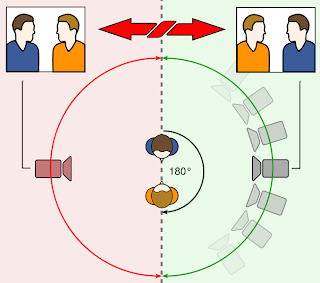
When taking into account our storyboard we kept to the main ideas that were in each scene, however we used different shot types in the scenes to make it more applicable to the way we represented our fiction film. We used the same shots at the start of our storyboard when showing the establishing shot and zooming into the house to suggest that this was where the next scene was taking place. However when filming our characters we used a variety of different camera angles and shots when it came to filming that we did not include in our storyboard. For example when filming the character on the phone we decided to have a close up of the phone and the face of the character when speaking, this contrasted with our storyboard where we decided to shoot this shot as a medium shot. We changed this because the close up was a lot more effective and we wanted to include a range of different shots in our film.
We wanted to film the whole extract of our fiction film within two to three days. This was also dependent on when our actors were free and what the weather was like due to the fact that we were filming outside for part of our film. Our time management was successful and we managed to complete filming in two days. We captured all the different shots we needed and collected and completed our ideas together on the day.
When it came to editing our film we realised that the sound had been knocked and temporarily broken near the end of filming. This mistake was not as costly as first thought as it occurred after all our characters dialogue. We were therefore able to put some backing music over the scenes with no background sound and this did not affect our film too badly. Within the preliminary exercise we realised that a big priority was to keep the camera straight and steady at all times, we also realised the importance having to capture every single shot in a scene even if we were not one hundred percent sure whether we would use it or not. Therefore we applied these learning curbs to our filming.
When filming we took it in turns to film, however we made sure that we were keeping to the storyline and that we included many angles and shots. Due to the fact that I am tall I shot the high angle shots and the over the shoulder shots. We had part of our crew that held the stands for the camera whilst we moved around to our different locations.
We gave the actors a general outline of what their character should do and what type of person they were. Seeing as the characters were meant to be cold, dark gangsters there was not a lot of dialogue. Before filming we searched the surrounding area of one of my team members houses and found a forest area with not a lot of people, which also created the perfect lighting for our film. Before filming we went to a store and bought a fake, plastic toy gun which we then painted black.
Saturday, 13 February 2010
Throughout the whole extract we used non-diegetic sound at different volumes which we were able to control on the editing software. We used two or three tracks which we overlapped at different points to make the sound out of beat and therefore intense and dark. For the diegetic sound we had the dialogue of the characters and also some background noises such as a crow which symbolised death and showed that something was wrong. We used special sound effects such as the gun shot which we found on the internet.
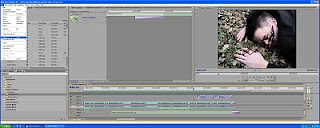
Friday, 12 February 2010
When capturing the clips we had filmed we went onto Adobe Premiere and recorded the whole clip onto the computer. Therefore when going through the film we could cut out any clips we did not need using the cut button on the editing keyboard.
Due to the different clips we had incorporated we did not stick solely to the pre production storyboard and in fact used a variety of different shots that had not been included at first. Therefore we improved our fiction film based on our filming which we pieced together when editing. There were some bits of the storyboard we left out whilst editing. This is because the shots did not go well together and we wanted our clips to flow easily together.

Special Effects
We changed the tone and lighting of the picture to make the pictures more in depth and rich in colour. This made a major difference to the atmosphere portrayed in the film as shown bellow.
This is the original picture before we edited the tone and colouring...
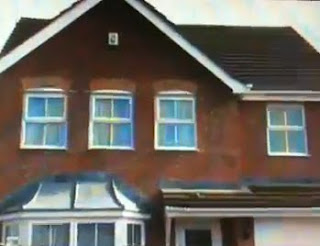
This is the picture after editing...
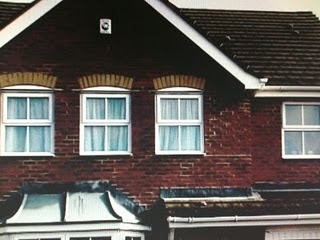
We added different effects to the film using the file ‘video transitions’. One of these effects we used was the cross dissolve. This was used in order make our cuts from one scene to another a lot smoother. We could choose whether we wanted the scenes to overlap a lot or not at all using the A and B icons shown in the picture below.
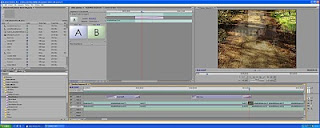
Another effect used was the ‘dip to black’ effect. We used this when zooming in from our establishing shot to the scene of the detective within the room. This was used to represent to the audience that the scene to come (the detective in the room) is occurring in that house. We believed that this cut was very smooth as the dip to black makes it possible to switch from the window to the swinging of the bag in the room. As we did in the cross dissolve we can similarly fade in and out using the A and B icons.
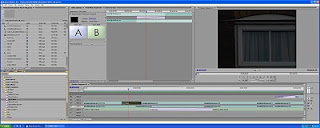
A final effect used was the slow motion clip at the end. This effect was used by reducing the time span on the clip; this therefore produced the slow motion effect. This effect went very well will the non-diegetic music which was slow and intense. This slow motion clip occurs just after Letch kills the detective. This makes the scene daunting and lets the audience take in what has just occurred as they hesitantly watch the well built mobster walk away in slow motion.
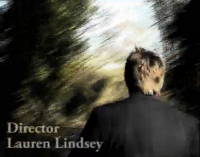
Titles
During the opening scene we were meant to include titles such as the film companies, the producer and the director. We used a bold, rough font to portray the rough crime genre of our film. The font used was called Adobe Garamond. We named the film Brief Case, this is a play on words and is a double entendre as the prop of concern is the briefcase, however the killing was done so brutally and quickly it could be called a ‘brief case’. We put the title all in caps lock so that the audience know that is the title of the movie. Due to the fact that we included a lot of walking in our opening sequence we decided to put the titles over the picture rather than on a black screen. I thought this worked really well as the titles were readable and you could still seeing what is going on in the picture. This also meant that we had to colour the titles white in order for the audience to be able to read them. The process in which we edited and applied the titles is shown below.
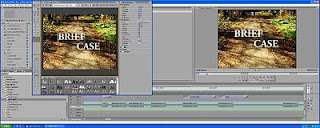
Thursday, 11 February 2010
Our fiction film was meant to portray an eerie and mysterious atmosphere and therefore when searching for our site to film we needed a space where it was desolate and possibly enclosed. We found a forest which was perfect due to the shadows cast by the trees and the lack of people within the scene.
Actors
When choosing our actors we needed two well built male actors who could be made to look like members of a mob, therefore when choosing their ‘costumes’, we made sure they were in suits to have a ‘mob or gangster’ members stereotypical appearance.
We did not want our actors to use a lot of dialogue so that our scenes could seem mysterious and therefore keep the audience ‘on the edge of their seats’ and keep them guessing at most points in the opening minutes we produced.
The only makeup needed when filming was when we had the close up shot on the character’s face who had been shot. For this we just used fake blood which we ran down the characters face to show that there had been blood gushing out his head.
We used two actors, one of which was one of my group member’s older brother (Daniel), and the other being the brother’s friend (Robert) who had a background of acting which was very helpful.
Props
The main props used within our fiction film were the dark briefcase, the brown bag filled with money, the gun and a mobile phone. The briefcase and brown bag were owned by one of my group members and the mobile phone seen in one of the close up shots was owned by the actor himself. We bought the gun in a random shop and then painted it black, this gun was good because it was big and bulky and therefore on screen it could easily be identified as a weapon. The brown bag filled which was meant to be filled with money was in fact stuffed with a pillow and then we scattered eight to ten, twenty pound notes on top to make it look like the bag was filled with money.
Filming and Ideas
We wanted to keep the order in which we filmed roughly in the same order we would have the final video. This was in order for us to not back track on what we had filmed and to have the same lighting in every scene. However when filming we filmed lots of different angles and points of view to ensure that we had every single shot possible when it came to editing and the scenes could therefore cut from one to another smoothly. Also when filming we tried to include a variety of different shots to show the scene clearly and to also use the camerawork to portray different ideas. For example we had a low angle shot looking up at one of our characters to portray that he was strong and superior compared to the other character.
When we originally came up with the idea of having a gangster themed thriller we wanted to use three characters. However we discovered that this was not realistic due to the fact that the storyline was too complex and our third actor that we would have used dropped out. As a result of this we had to change our idea for the ending of our opening scene. We thought that the killing off of one our characters at the end of our opening scene would shock the audience and get them prepared for a thrilling and suspenseful film. The main basis of the story we first came up with was still used, for instance putting some ‘evidence’, i.e. the gun, into the briefcase at the start to show that some sort of dangerous or dodgy deal was about to occur in the opening scene. We did not want to make the opening scene too complicated and therefore just the simple walking of our character out of his house towards the other character would be a good opportunity to put some non-diegetic music in the background to create a solemn and ‘spooky’ tone. It would also be a good opportunity to put some titles on screen which is very important when making our opening scene to our fiction film.
There were some unexpected good moments when we filmed the last minute or so of the opening scene. We filmed on a sunny day and therefore the shadows cast by the trees in the little walkway/forest area we used were very effective. Therefore when our character pulled out the gun to shoot, the shadow of the gun was cast perfectly onto a tree within the scene. This therefore highlighted the importance and threat of the gun in that scene. Some more unexpected good moments that occurred was when we decided to keep the ambient sound to show the atmosphere of the forest area. There was a sound of a crow which symbolises evil and therefore in this scene it helped us portray the fact that something bad was about to occur.
Health and Safety Issues
There were not many health and safety issues, we filmed part of our film in a secure house and the other part in a desolate area so therefore there was not a lot of people who could pose any possible threat. However when filming a high angle shot that we were very impressed with and in fact used in our film there was a little bit of a safety risk. One of our group members went on one of the actors shoulders on a high ledge and filmed. However this did not go wrong and no health or safety threat occurred.
Lighting
Within the house when the character was putting the gun into the briefcase and making a call we dimmed the lights in the room. We turned on a lamp which was placed on the desk next to the character which perfectly showed what was occurring within the scene and cast some effective shadows which made it look daunting and therefore would create a suspenseful atmosphere.
When filming outside and in the forest area we used the natural light from the sun. There was a lot of shade due to the trees which ensured that the scene was not too bright. The shadows cast by the trees also gave us an opportunity to highlight the key props within a scene, for instance the gun.
Sound
Diegetic sound used within the scenes was the dialogue said by the characters and the clicking of the briefcase closing. There was also ambient sound used when the two characters had a discussion outside and settled the deal. This was used instead of a backing track to produce an outdoor atmosphere. There was a lot of non-diegetic sound used such as the soundtrack which raised its tempo as the character was getting closer and closer to making the deal. We used some sound effects such as the gun shots when one of the characters shot the other character.
Camera
The camera (Canon XL1S) we used to film the opening scene was easy to carry around. We also used a tripod and some attachable wheels in order for our shots to be still and for our skewing to go across or up or downwards in a perfect line.
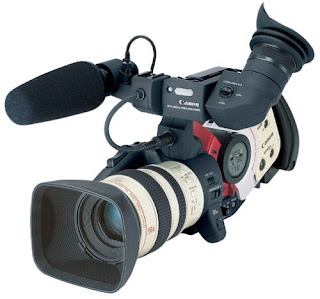
Wednesday, 10 February 2010
The final title sequence to our film was produced; however there were issues with the sound which affected the atmosphere we wanted to portray and also the audience’s interpretation of the narrative. Therefore we changed around the timings of the music so it corresponded with the picture and made it more affective. For instance we made it so the end of the high pitched intense music ended when the detective closed the zip of the bag of money. Contrasting booming music started to play to suggest that there was no going back and something bad was about to occur. We also had to turn the volume of the dialogue up so that the audience could hear clearly what the characters were saying in order for them to understand the narrative. A final change we made was adding a cross dissolve in just after the title ‘Brief Case’ appeared on the screen.
The previous title sequence before these changes were introduced is shown below, you therefore compare the contrast between this clip and the finalised clip at the top.
Tuesday, 9 February 2010
This questionnaire was produced after our finalised version of ‘Brief Case’. We showed our screening to an audience and then gave them a questionnaire which we have generalised in the pie charts below.
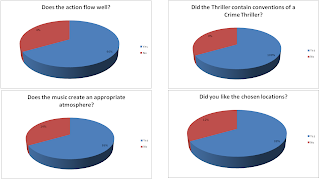
I was very pleased with the positive feedback received. We had certainly represented the conventions of a crime thriller due to the fact that we received a 100% response confirming the thriller contained the conventions of a crime thriller. I was also pleased to note that our filming and editing skills had paid off due to the fact that a high percentage of people said that the action flowed well within our thriller.
Monday, 8 February 2010
We told the actors what type of role they needed to play and prepared them for how they should come across to the camera. We also produced a script which was mainly stuck to but at the time of filming we also found ourselves improvising, however always keeping the script as a baseline. There is little dialogue due to the fact that we wanted create an eerie atmosphere and more therefore there are more directions on the script shown below.
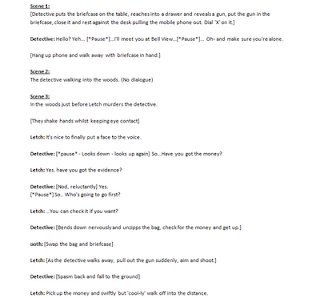
Sunday, 7 February 2010
I chose this location for my thriller sequence, because I decided that it was going to be hard to get permission to film in a public place. This location was attractive for us because there were no members of the public around and the shadows cast by the trees proved to be the perfect lighting for our film. The location was local to where we were originally filming. There were high ledges at the edges of the walk way, so this therefore made it easier for us to film long shots and high angled shots.
After gaining all our ideas together from different sources such as the questionnaire and our different movie influences we all had a main idea as to how we would construct our open sequence to our thriller. We therefore drew this out on a storyboard as shown:
Background knowledge on the storyline is that there is a detective who has evidence to bring down a top criminal who is being held in custody. If this evidence is presented in court the criminal will go to jail for life. However the detective has another option and can take the ‘bent copper’ path if he chooses. The detective chooses this path and arranges to meet with a representative of the criminal in custody where he will therefore swap the evidence for a large amount of money. In this pre production title sequence the following is therefore shown. There is the establishing shot of the house and it then shows the detective within the house sorting out all the different pieces of evidence. He then receives a call from a criminal contact he has been tracking who tells him where to meet so they can make a swap between the evidence and substantial amount of money. The detective therefore leaves the house and walks towards the road he is meant to meet the contact on. When meeting the contact they exchange words and hope to make the swap without any interruptions. However when the detective goes to take the bag of money the criminal contact pulls out a gun and kills him. This therefore results in the detective lying dead on the road whilst the criminal walks off with the evidence and the money.
Saturday, 6 February 2010
The use of the questionnaire was to determine what different conventions and different aspects of a movie an audience would want to see in our thriller. We had a main idea that we wanted to incorporate the genre of crime and violence, but we did not know what way to go about it. Therefore we created this questionnaire online to guide us to our final film.
The target audience for our film was teenagers and we therefore issued out the questionnaire to people of ages 16-18. However we did not have a gender specific idea for this movie and therefore to gain a fair amount of results we issued the questionnaire out to 40 people, 20 males and 20 females. Within our questionnaire we wanted a variety of different styled questions so we could gain as much information as we can where needed. We therefore included multiple choice questions and open questions where the audience could write a more detailed answer.
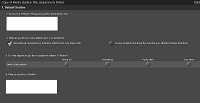
The Questionnaire
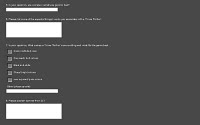
After recieving all the results back from our questionnaires we were able to represent this in a pie chart where it would be easier to determine what we should include in our thriller.
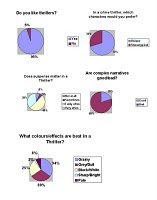
I can therefore conclude from the results gained that we now have a much better image of which path we would like to take when producing our thriller. The results tell us that the unique character is the most preferred and although suspense is rather important within a thriller, it must not be too complex.
Friday, 5 February 2010
Preliminary Task
Over the course of two weeks I worked in a group of three people where we produced our preliminary task. When engaging in this task I learnt how to use a camera first hand. I learnt what all the different functions on the camera did and how they manipulated the outcome of the final video, for example how to white balance. I also learnt how to edit the video on the computers.
When filming in this task we used a variety of basic shots such as:
Establishing shot
Panning (following the character in a scene)
Over the shoulder shot
Close up
Long shot
Medium shot
When filming you still have to keep editing very much in mind. For instance when beginning and ending a scene you have to wait three seconds before the character can start moving. As a result of this when one comes to edit it is easy to make quick and accurate cuts between shots.
Within the Preliminary I filmed the opening scene and the cuts from when the first door is opened. When doing this I had to pan the camera whilst following the character and use a long shot to establish the scene and the identity of the character. I also edited most of the opening scene; this included the opening of both doors where we used quick cuts to and from different points of view to show the character opening the door.
Editing the preliminary task was very helpful because it meant I could become aware of the different editing software on the computer. Therefore when editing my opening sequence to the thriller I can use special affects to enhance the quality of the final video produced.
The preliminary task also helped our group ponder different ideas for our opening to our thriller. We liked the idea of using the lighting to make shadows on a wall or floor which we could film; this therefore would make a scene feel tense and suspicious which is what our group is aiming for in our thriller.